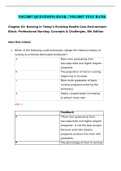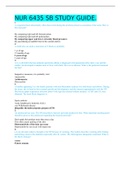GRADUATE
HERE WE GRADUATE!! WE OFFER BEST TUTORIAL SERVICES
- 236
- 0
- 1
Community
- Followers
- Following
17 Reviews received
237 items

ATI TEAS MATH - TEAS 6
ATI TEAS MATH - TEAS 6 Mixed Review Part 1 (These questions are similar problems 1 through 4 found in the Mathematics Section Quiz in the ATI Teas Study Manual). 1a. Convert 1/5 to it's equivalent decimal and percent. 1b. Convert 1.28 to it's equivalent fraction and percent. 1c. Convert 46.2% to it's equivalent fraction and decimal.
- Exam (elaborations)
- • 27 pages •
ATI TEAS MATH - TEAS 6 Mixed Review Part 1 (These questions are similar problems 1 through 4 found in the Mathematics Section Quiz in the ATI Teas Study Manual). 1a. Convert 1/5 to it's equivalent decimal and percent. 1b. Convert 1.28 to it's equivalent fraction and percent. 1c. Convert 46.2% to it's equivalent fraction and decimal.

NSG 320 COMPREHENSIVE VERSION 2 | VERIFIED SOLUTION
NSG 320 COMPREHENSIVE VERSION 2 1. A nurse is planning care for a preschool-age child who is in the acute phase of Kawasaki disease. Which of the following interventions should the nurse include in the plan of care? a. Give acetaminophen to control the child’s fever B. Monitor the client’s cardiac status (Peds p120) c. Administer antibiotics via intermittent IV bolus for 24 hrs d. Provide stimulation with children of the same age in the playroom 2. A nurse observes a client on the psyc...
- Exam (elaborations)
- • 20 pages •
NSG 320 COMPREHENSIVE VERSION 2 1. A nurse is planning care for a preschool-age child who is in the acute phase of Kawasaki disease. Which of the following interventions should the nurse include in the plan of care? a. Give acetaminophen to control the child’s fever B. Monitor the client’s cardiac status (Peds p120) c. Administer antibiotics via intermittent IV bolus for 24 hrs d. Provide stimulation with children of the same age in the playroom 2. A nurse observes a client on the psyc...

NCLEX PRACTICE TEST BANK
the mother understands safety precautions with her four month-old infant and her 4 year-old child? Review Information: The correct answer is D: "I have the four year-old hold and help feed the four month-old a bottle in the kitchen while I make supper." The infant seat is to be placed on the rear seat. Small children and infants are not to be left unsupervised. Infants are to be placed on their "back when they go back" to sleep or are lying in a crib. A 4 year-old could assist with the c...
- Exam (elaborations)
- • 151 pages •
the mother understands safety precautions with her four month-old infant and her 4 year-old child? Review Information: The correct answer is D: "I have the four year-old hold and help feed the four month-old a bottle in the kitchen while I make supper." The infant seat is to be placed on the rear seat. Small children and infants are not to be left unsupervised. Infants are to be placed on their "back when they go back" to sleep or are lying in a crib. A 4 year-old could assist with the c...

NSG3007 QUESTIONS BANK / NSG3007 TEST BANK
NSG3007 QUESTIONS BANK / NSG3007 TEST BANK Chapter 01: Nursing in Today’s Evolving Health Care Environment Black: Professional Nursing: Concepts & Challenges, 8th Edition MULTIPLE CHOICE 1. Which of the following could eventually change the historical status of nursing as a female-dominated profession? a. More men graduating from baccalaureate and higher degree programs b. The proportion of men in nursing beginning to increase c. More male graduates of basic nursing programs ente...
- Exam (elaborations)
- • 7 pages •
NSG3007 QUESTIONS BANK / NSG3007 TEST BANK Chapter 01: Nursing in Today’s Evolving Health Care Environment Black: Professional Nursing: Concepts & Challenges, 8th Edition MULTIPLE CHOICE 1. Which of the following could eventually change the historical status of nursing as a female-dominated profession? a. More men graduating from baccalaureate and higher degree programs b. The proportion of men in nursing beginning to increase c. More male graduates of basic nursing programs ente...

Case 13 Coronary Artery Disease and Coronary Artery Bypass Surgery (CAD: CABG CASE STUDY)
NUR 401 Case 13 Coronary Artery Disease and Coronary Artery Bypass Surgery (CAD: CABG CASE STUDY) Scenario Your patient, 58-year-old K.Z., has a significant cardiac history. He has long-standing coronary artery disease (CAD) with occasional episodes of heart failure (HF). One year ago, he had an anterior wall myocardial infarction (MI). In addition, he has chronic anemia, hypertension, chronic renal insufficiency, and a recently diagnosed 4-cm suprarenal abdominal aortic aneurysm. Because of his...
- Case
- • 6 pages •
NUR 401 Case 13 Coronary Artery Disease and Coronary Artery Bypass Surgery (CAD: CABG CASE STUDY) Scenario Your patient, 58-year-old K.Z., has a significant cardiac history. He has long-standing coronary artery disease (CAD) with occasional episodes of heart failure (HF). One year ago, he had an anterior wall myocardial infarction (MI). In addition, he has chronic anemia, hypertension, chronic renal insufficiency, and a recently diagnosed 4-cm suprarenal abdominal aortic aneurysm. Because of his...

NUR 6435 SB STUDY GUIDE.
NUR 6435 SB STUDY GUIDE. 1. A congenital heart abnormality often discovered during the newborn period is coarctation of the aorta. How is this assessed? By comparing right and left femoral pulses By comparing right and left pedal pulses By comparing upper and lower extremity blood pressures By auscultating an audible bruit in the carotid arteries 2. A child who can stack a maximum of 5 blocks is probably: 1 yr of age 15 months of age 2 years of age 3 years of age 3. A 6 yr old ch...
- Exam (elaborations)
- • 29 pages •
NUR 6435 SB STUDY GUIDE. 1. A congenital heart abnormality often discovered during the newborn period is coarctation of the aorta. How is this assessed? By comparing right and left femoral pulses By comparing right and left pedal pulses By comparing upper and lower extremity blood pressures By auscultating an audible bruit in the carotid arteries 2. A child who can stack a maximum of 5 blocks is probably: 1 yr of age 15 months of age 2 years of age 3 years of age 3. A 6 yr old ch...

NSG6006 Pre-specialty Evaluation Exam
NSG6006 Pre-specialty Evaluation Exam pg 5 to 7. 45. What terms indicate appropriate progression associated with the history and evolution of advance practice nursing? Specialist, Expanded Role, Advanced Practice 46. An experienced NP, has two separate but equally important ethical obligations that he is unfortunately unable to carry out. This is an example of which barrier to ethical practice? Moral Dilemma 47. Pre-invasive epithelial tumors of glandular or squamous cell origin desc...
- Exam (elaborations)
- • 3 pages •
NSG6006 Pre-specialty Evaluation Exam pg 5 to 7. 45. What terms indicate appropriate progression associated with the history and evolution of advance practice nursing? Specialist, Expanded Role, Advanced Practice 46. An experienced NP, has two separate but equally important ethical obligations that he is unfortunately unable to carry out. This is an example of which barrier to ethical practice? Moral Dilemma 47. Pre-invasive epithelial tumors of glandular or squamous cell origin desc...

PHARM ATI STUDY GUIDE
PHARM ATI STUDY GUIDE Pharm Q5- Hematology ------------------------------------ATI BOOK CH. 23--------------------------------------------- 1. A nurse is assessing a client who is taking amiodarone to treat atrial fibrillation. Which of the following findings is a manifestation of amiodarone toxicity? Light yellow urine Report of tinnitus X Productive cough Blue-gray skin dicoloration 2. A nurse is caring for a client who received IV verapamil to treat supraventricular tachycard...
- Exam (elaborations)
- • 23 pages •
PHARM ATI STUDY GUIDE Pharm Q5- Hematology ------------------------------------ATI BOOK CH. 23--------------------------------------------- 1. A nurse is assessing a client who is taking amiodarone to treat atrial fibrillation. Which of the following findings is a manifestation of amiodarone toxicity? Light yellow urine Report of tinnitus X Productive cough Blue-gray skin dicoloration 2. A nurse is caring for a client who received IV verapamil to treat supraventricular tachycard...

MED SURG →PRIORITY TWO
MED SURG →PRIORITY TWO 1. A nurse is assessing a client who is 12hr postoperative following a colon resection. Which of the following findings should the nurse report to the surgeon? a. Heart rate 90/min b. Absent bowel sounds c. Hgb 8.2 g/dl d. Gastric pH of 3.0 Rationale: Normal Hgb is 13-18M g/dl, 12-16 g/dl. This may indicate a possible hemorrhaging. 2. A nurse is caring for a client who has diabetes insipidus. Which of the following medications should the nurse plan to administ...
- Exam (elaborations)
- • 20 pages •
MED SURG →PRIORITY TWO 1. A nurse is assessing a client who is 12hr postoperative following a colon resection. Which of the following findings should the nurse report to the surgeon? a. Heart rate 90/min b. Absent bowel sounds c. Hgb 8.2 g/dl d. Gastric pH of 3.0 Rationale: Normal Hgb is 13-18M g/dl, 12-16 g/dl. This may indicate a possible hemorrhaging. 2. A nurse is caring for a client who has diabetes insipidus. Which of the following medications should the nurse plan to administ...

CRITICAL CARE TESTBANK EXAM 2 |VERIFIED SOLUTION
CRITICAL CARE TESTBANK EXAM 2 Chapter 08: Hemodynamic Monitoring 1. The nurse is caring for a 100-kg patient being monitored with a pulmonary artery catheter. The nurse assesses a blood pressure of 90/60 mm Hg, heart rate 110 beats/min, respirations 36/min, oxygen saturation of 89% on 3 L of oxygen via nasal cannula. Bilateral crackles are audible upon auscultation. Which hemodynamic value requires immediate action by the nurse? a. Cardiac index (CI) of 1.2 L/min/m3 b. Cardiac output (CO) of...
- Exam (elaborations)
- • 60 pages •
CRITICAL CARE TESTBANK EXAM 2 Chapter 08: Hemodynamic Monitoring 1. The nurse is caring for a 100-kg patient being monitored with a pulmonary artery catheter. The nurse assesses a blood pressure of 90/60 mm Hg, heart rate 110 beats/min, respirations 36/min, oxygen saturation of 89% on 3 L of oxygen via nasal cannula. Bilateral crackles are audible upon auscultation. Which hemodynamic value requires immediate action by the nurse? a. Cardiac index (CI) of 1.2 L/min/m3 b. Cardiac output (CO) of...

MATH 225N FINAL EXAM 2 – QUESTION AND ANSWERS
INET HESI RN V1 ACTUAL TEST SCREENSHOTS
INET HESI RN V1 ACTUAL TEST SCREENSHOTS
INET HESI RN V1 ACTUAL TEST SCREENSHOTS
INET HESI RN V1 ACTUAL TEST SCREENSHOTS